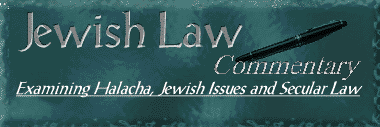

The Need for Internal
Community Cooperation
Dr. Marvin Schick
The Need for
Internal Community Cooperation
Dr. Marvin Schick*
New York has enacted legislation providing tax relief to families with school-age children. It was passed over the veto of Governor Pataki who advocated a different approach that would have provided greater and more direct assistance to a smaller number of yeshiva and day school parents. Either approach would result in a modest, yet significant, benefit and for this we should be grateful.
I would have preferred legislation that puts money directly into school coffers, patterned after the New York Textbook and Mandated Services legislation of more than a generation ago. While direct aid to schools under religious sponsorship raises constitutional issues that the new legislation likely avoids, I believe that the high-cost security and energy needs of parochial schools would have provided a sufficient constitutional leg to stand on.
One of the interesting features of recent developments is that the various segments of the Orthodox community essentially went on their separate ways. The new legislation offered a critical opportunity for Orthodox leaders and groups to sit down and try to work out a common strategy. Dream on. Orthodox leaders rarely meet these days across the communal divide, nor are they inclined to pick up the phone to discuss with persons outside of their small zone issues of critical importance. It seems at times that it is easier to get them to break bread with secular Jews than with fellow Orthodox of a somewhat different religious stripe.
Variety and conflict are inherent in religious experiences because people of faith inevitably disagree over what their faith requires. It should not be surprising or disturbing that we Orthodox Jews are awash in disagreement over halachic and hashkafic issues. Our history and responsa demonstrate that wherever Jewish life flourished, there was conflict regarding practices and, at times, even beliefs. There was, of course, consensus over fundamentals.
In the American experience, intra-Orthodox conflict was muted for an extended period, mainly because the Orthodox were weak and meek. With the emergence in the post-Holocaust years of a more assertive Orthodoxy, there was heightened conflict over Israel, relationships with the non-Orthodox, secular education and other matters. There was also a pattern of cooperation regarding a host of communal activities. In a sense, unity and disunity coexisted.
Decades ago, there was intense, even nasty, battling over membership in religious bodies together with non-Orthodox clergy and congregations, as well as the draft of young women into the Israeli army or the requirement that they do national service. These conflicts were serious business and they left scars. Yet, they did not impede cooperation between the different segments of Orthodoxy, as for example in the building of the day school movement in the U.S. or support for Chinuch Atzmai, the network of independent religious schools in Israel. Rav Aharon Kotler, the transcendent Torah leader, was at the center of this activity and though he was fiercely committed to intense Torah study and rigorous standards, he strenuously reached out to leaders across the spectrum of Orthodoxy.
When the National Jewish Commission on Law and Public Affairs or COLPA came into being forty years ago and I become its first president, conflict between the modern Orthodox and yeshiva world was not a barrier to cooperation on government aid to parochial schools or efforts to protect Sabbath observers against workplace discrimination. COLPA’s briefs were signed by all Orthodox groups.
Nowadays, although differences remain over various practices and beliefs, there is a higher degree of unity at both the personal and communal levels. The Synagogue Council is no more, while conflict over Israel has abated. The Daf Hayomi experience and ArtScroll have forged a bond that unites Orthodox Jews in Torah study. It is true that yeshivas and day schools often operate like incompatible institutions and there are yawning differences regarding dress and other behaviors, specifically including how best to react to the outside world. But the separate communal segments are not at war.
Unfortunately, they also do not cooperate and interact as they once did. Each segment of Orthodoxy is on its own, making Shabbos for itself and frequently acting as if there are no other parts to be reckoned with. Leaders do not meet or talk and there scarcely are any forums for group interaction. This for a people who comprise perhaps 10-12% of American Jewry. The absence of intra-communal contacts certainly arises more from lifestyle changes than from ideology. Families are larger, we all have many more events to go to, most of us want to engage in Torah study and we can scarcely keep up with the barrage of messages coming our way through email, cell phones and whatever else technology has wrought. We are struggling to catch our breath and scarcely have time or energy for the sort of communal activity that once was esteemed.
Still, organizational ego serves as a barrier. In a way, each segment of Orthodoxy which represents no more than 2-3% of all of American Jews is saying that its four cubits are what count. This also means that increasingly we are saying that there is no one Orthodox community.
This diminishes our capacity to achieve mutual goals. It is telling – or should be – that for all of the noise coming from certain Orthodox groups that trumpet their achievements, over the last generation American Orthodoxy has achieved very little in the legislative and legal arenas. By dividing ourselves into little boxes, we have put on display our smallness. Interestingly, the New York legislative achievement is substantially the result of the efforts of people in the Syrian Jewish community.
Our current instinct to go it alone also results in the distortion of the past in order to make it compatible with how we now act and feel. An English language book has just been published on the life and teachings of the great Roshe Yeshiva of Lakewood. I trust that it has much merit, but it also puts on display the problem we face. There is a photograph from the first Chinuch Atzmai dinner which was held more than a half century ago. Amazingly, Rabbi Joseph B. Soloveitchik has been cropped out of the picture. What makes this distortion especially egregious is that he was at the dinner because Rav Aharon Kotler pleaded with him to come and be the main speaker. I might add that his speech was a memorable occasion that I still cherish fifty years later. It served as an expression of how our most eminent leaders from different segments of Orthodoxy knew of their obligation to work together.
I am saddened by our inability to recognize that those who accept Torah and mitzvos are all part of a single community and that whatever our inevitable differences, we are obliged to cooperate. For fifty-five years my communal life has been predicated on the principle that whatever my personal choices, I am part of a community whose well-being requires a high degree of internal cooperation. I was active in both Agudath Israel and the Orthodox Union throughout the 1960’s. In COLPA, I strove to link our disparate parts to achieve crucial goals. In all of my chinuch activity - the commitment that most defines what I stand for – I have been involved across the spectrum of Orthodox life. RJJ is an embodiment of this commitment.
What I stand for is a perspective that increasingly is shared by fewer and fewer people.
Reflections on the Jewish Foundation School
The following lines may be regarded as an addendum to the preceding brief essay.
RJJ is in its one-hundred seventh year. In this extended period, few decisions were more significant than our determination to assist and take some responsibility for the Jewish Foundation School, a modern Orthodox day school located on Staten Island which was in extreme financial distress. This was a remarkable and probably unprecedented act of communal altruism, made more remarkable because RJJ was assuming the substantial debt of an entirely separate school whose curriculum and educational approach were different from ours.
It is possible that JFS would have survived without RJJ’s intervention. That was an outcome that we were not going to put at risk because if JFS closed, there would be no substitute institution for a substantial portion of its student body.
The cost to RJJ has been enormous, the least of it in dollar terms. Essentially, we committed our limited energy and intellectual resources to strengthening JFS and to maintaining its mission. This reduced our capacity to undertake other activities and it also reduced the willingness of some to participate in or support RJJ’s work. Almost immediately, there was a decline in contributions and this has continued, including – and this is remarkable – from persons on Staten Island.
I have thought often about what we did years ago, wondering whether it was wise to weaken ourselves so that another school survive. The question has become more urgent because past and potential contributors look at an RJJ that is tied to three Staten Island elementary schools (plus, of course, the Edison mesivta and beth medrash) and this is an arrangement that they are not inclined to support.
There is another side to the picture, good results that we can point to, including the fine Judaic and secular education provided to JFS’s four-hundred students. While it is not identified as a kiruv or outreach school, a substantial percentage of its students fit into this category, many enrolling through a project called Oorah. We recently reviewed the educational choices made by these students after they completed JFS. It turns out that eighty-five percent of those who came from marginally observant or non-observant homes have continued on to a Jewish high school. This is a wonderful statistic and while the consequences of what we did for JFS continue to occupy our thoughts, there are good reasons why we should be proud.
________________________________________
* Reprinted from the May 2006 issue of The RJJ Newsletter with the permission of Dr. Marvin Schick.

DISCLAIMER